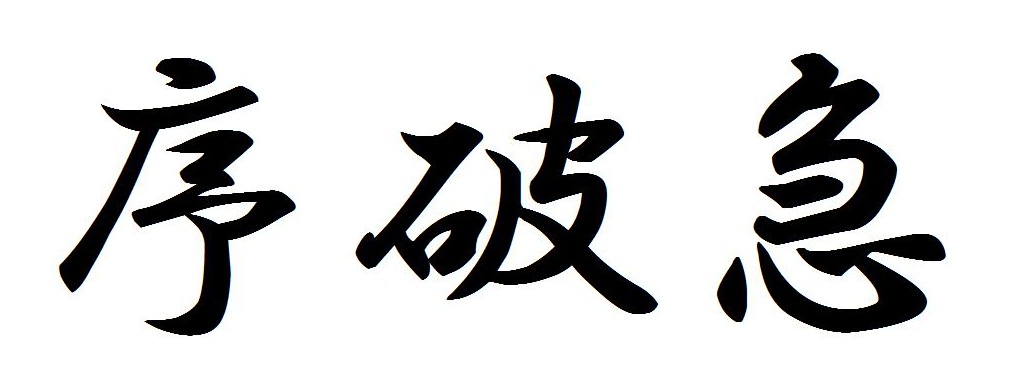*The target readers are those who will make a speech or a presentation in Japanese.
序 (Jo), 破 (Ha) 急 (Kyu) Structure is a concept of modulation and movement coming from Japanese traditional arts; GaGaku which is said to be the oldest orchestra in the world. In this day and age, it is applied to movies and Japanese scripts. One of its strengths is that it can make your script lively, exciting and attractive to your audience. In this article, you will learn how you can utilize the 序 (Jo), 破 (Ha) 急 (Kyu) Structure for your Japanese script.
Japanese Traditional Method of Structuring Japanese Script : Jo-Ha-Kyu
序 (Jo)
The Chinese character, 序 (Jo) means preface, beginning, order, precedence, occasion, chance, incidentally, etc. In this part, you will explain some key points, such as main characters, their backgrounds, their relationships and the world they live in. The ups and downs of your script are important in this structure. However, since this is the beginning, this part should be calmer than the rest of your script.
Example
私の家族は父、母、弟の4人です。
My family is my father, mother and younger brother.
子供の頃、私はサッカー選手、弟は医者になることが夢でした。
When we were children, my dream was to become a football player and my brother’s was to become a doctor.
両親は私たちの夢を応援してくれていて、家族とても仲良く暮らしていました。
My parents supported our dream and we spent happy days together.
破 (Ha)
The Chinese character, 破 (Ha) means broken, damaged, worn out, break, split, destroy, defeat, etc. In this part, you are going to set a stage for the conflict like a Tsunami about to break on the shore. At the beginning, you are going to lead your main characters smoothly, but at this point, something suddenly happens, which can be something like meeting one’s partner, failing in love, or losing something or someone. After that, it will start kind of a new story.
Example
私たちが高校生のとき、本格的に夢への挑戦を始めました。
When we were high school students, we started fully focusing on our dreams.
弟は学校の成績も一番で、有名な研究所に行くことが決まりました。
My brother got top marks in school and got an offer to join a well-known research institute.
すべてが上手くいっているようでしたが、ある日、弟は交通事故にあいました。そして死にました。
It looked like everything was going well. However, one day, he got a traffic accident and was killed.
ショックでその後自分が何をしたらいいのかわからなくなりました。サッカーの練習も止めてしまいました。
I didn’t know what to do after that because of the shock. I even stopped practicing football.
なぜお医者さんたちが弟を助けてくれなかったのか、そればかり考えていました。
I was obsessed by a question; why the doctors could not revive him.
[adsense]
急 (Kyu)
The Chinese character, 急 (Kyu) means urgent, urgency, anxious, to worry, rapid, emergency, sudden, pressing, fast, etc. In this part, you are going to have the climax of your script and all problems should be resolved. Your audience may feel your story ends suddenly. In fact, the 序 (Jo), 破 (Ha) 急(Kyu) Structure is such a way of leading them to reflect on the conclusion, which can be happy or unhappy. It is said that the ratio of the number of sentences should be 25% at 序 (Jo), 50% at 破 (Ha) and 25% at 急 (Kyu).
Example
そして、私は今、医科大学で医者になるための勉強をしています。
Now, I am learning at a medical university in order to become a doctor.
私は気づいたのです。私がいくら落ち込んでいても弟は帰って来ないと。
I realized he wasn’t coming back even if I were so disappointed.
だから私は弟の夢を代わりに追いかけることにしました。
So, I decided to pursue his dream instead of him.
多くの命を救う医者になること、それが今の私の夢です。
My current dream is to become a doctor who can save many people’s lives.
Pros and Cons
序 (Jo), 破 (Ha) 急 (Kyu) Structure is appropriate for making a narrative story and not appropriate for telling something logically, similar to the 起 (Ki), 承 (Sho), 転 (Ten), 結 (Ketsu) Structure. One of the differences between them is simply the number of paragraphs; 3 and 4, respectively. Thus, the 序 (Jo), 破 (Ha) 急 (Kyu) Structure will work well when writing short Japanese scripts as opposed to the 起 (Ki), 承 (Sho), 転 (Ten), 結 (Ketsu) Structure will do when writing long ones.
Conclusion
In regards to making a Japanese script for your speech, it is recommended because it has no effect on your presentation skills. With the 序 (Jo), 破 (Ha) 急 (Kyu) Structure, the scenarios become the focus of the speech, rather than your ability to deliver it, although delivery is important. Our advice is to be confident. Have the audience on the edge of their seat, trying to guess what will happen next. If you hesitate and look nervous, the audience will only focus on that. Do your best to be bold when you speak.
Recommended Link
Imitate Great Speaker: How to Write Your Japanese Script
Road-Map: How to Make Your Japanese Speech
For Your Japanese Speech; Imitate Great Speakers II
Enhance Your Japanese Script Ki Sho Ten Ketsu Structure
Apply the Essay Structure to Your Japanese Script
Author and English Editor
Author – Takuya Tokiwa
Takuya is the co-founder, Project Director of Wasabi and a serial entrepreneur in the education field. He is utilizing all of his knowledge and experiences for innovating Japanese learning.
English Editor – Natalia Weiner
Natalia is the Editor and Web Content Manager of Wasabi. She majored in Writing with a minor in Journalism and graduated from Loyola University Maryland in 2013. She was the Assistant Content Editor for the popular culture website EmcBlue, and has written and edited for a variety of publications in both Japan and the United States.





